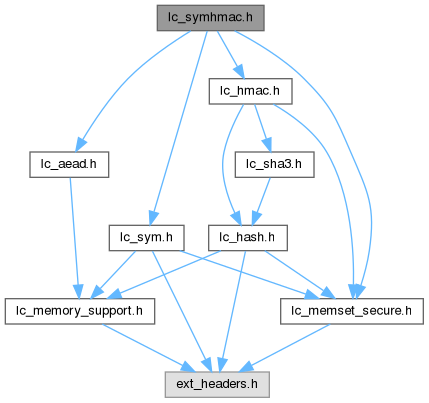 Include dependency graph for lc_symhmac.h:
Include dependency graph for lc_symhmac.h:Go to the source code of this file.
Macros | |
| #define | LC_SH_CTX_ON_STACK(name, sym, hash) |
| Allocate stack memory for the symmetric/HMAC cryptor context. | |
Functions | |
| int | lc_sh_alloc (const struct lc_sym *sym, const struct lc_hash *hash, struct lc_aead_ctx **ctx) |
| Allocate symmetric algorithm with HMAC cryptor context on heap. | |
Macro Definition Documentation
◆ LC_SH_CTX_ON_STACK
| #define LC_SH_CTX_ON_STACK | ( | name, | |
| sym, | |||
| hash ) |
Allocate stack memory for the symmetric/HMAC cryptor context.
- Parameters
-
[in] name Name of the stack variable [in] sym Symmetric algorithm implementation of type struct lc_sym used for the encryption / decryption operation [in] hash HMAC implementation of type struct lc_hmac used for the HMAC authentication
Definition at line 322 of file lc_symhmac.h.
Function Documentation
◆ lc_sh_alloc()
| int lc_sh_alloc | ( | const struct lc_sym * | sym, |
| const struct lc_hash * | hash, | ||
| struct lc_aead_ctx ** | ctx ) |
Allocate symmetric algorithm with HMAC cryptor context on heap.
Specification of Symmetric / HMAC AEAD Algorithm
This specification defines a symmetric stream cipher algorithm using the authenticated encryption with associated data (AEAD) approach. This algorithm can be used to encrypt and decrypt arbitrary user data. The cipher algorithm uses a symmetric algorithm to encrypt/decrypt data along with a HMAC to perform the data authentication. The keys for both the symmetric algorithm as well as the HMAC are derived from the caller-provided key. The result of the HMAC authentication is the message authentication tag which is used during decryption to verify the integrity of the ciphertext.
Introduction
This specification defines a symmetric algorithm using the authenticated encryption with additional data (AEAD) approach. This algorithm can be used to encrypt and decrypt arbitrary user data.
The base of the algorithm is the encryption / decryption of the data using the symmetric algorithm and the authentication of the ciphertext with a HMAC.
The algorithm applies an Encrypt-Then-MAC by calculating a message authentication tag using HMAC over the ciphertext. During decryption, this calculated message authentication tag is compared with the message authentication tag obtained during the encryption operation. If both values show a mismatch, the authentication fails and the decryption operation is terminated. Only when both message authentication tags are identical the decryption operation completes successfully and returns the decrypted message.
The caller-provided key is inserted into a HKDF to derive the key for the symmetric algorithm as well as the HMAC. The caller-provided IV is inserted into the symmetric algorithm.
The size of the key is defined to be 256 bits. The size of the IV is defined by the choice symmetric algorithm.
As part of the authentication, the algorithm allows the addition of additional authenticated data (AAD) of arbitrary size. This AAD is inserted into the authentication HMAC instance during calculating the message authentication tag.
The algorithm matches the specification of [SP800-38F] section 3.1.
Symmetric/HMAC-based AEAD Cipher Algorithm
Notation
The "Sym" algorithm denotes an arbitrary symmetric algorithm function, such as AES-CBC, AES-CTR or similar [SP800-38A]. The "Sym" algorithm has 4 arguments: the symmetric algorithm type such as AES-CBC, the main input bit string, the key and the IV. It produces an output string of equal size of the input. It may be possible that the algorithm operates on a fixed block size where the input bit string must be a multiple of the block size. The caller must ensure that the input bit string is a multiple of the block size.
The "HASH" algorithm denotes an arbitrary hash algorithm such as [FIPS180-4]. The "HASH" algorithm is used to instantiate the following algorithms. The following algorithms are required to use the same "HASH" algorithm. The type of the hash algorithm must be selected by the caller.
The "HMAC" algorithm denotes an arbitrary HMAC algorithm function, such as HMAC-SHA2-512 [FIPS198]. The "HMAC" algorithm has 3 arguments: the used hash type such as SHA2-512, the main input bit string, and the key. The output size is defined by the used underlying hash digest size.
The "HKDF" algorithm denotes the HKDF algorithm specified in [RFC5869]. The "HKDF" algorithm uses 5 input arguments: the used hash type such as SHA2-512, the IKM (input key material), the salt, the label and the size of the output string in bits.
Derivation of Symmetric and HMAC key
The common processing of data is performed as follows:
Calculating of Message Authentication Tag
The calculation of the message authentication tag is performed as follows:
Encryption Operation
The encryption operation is performed as follows:
Decryption Operation
The decryption operation is performed as follows:
If the authentication result indicates a failure, the result of the decryption operation SHALL be discarded.
Normative References
[FIPS180-4] FIPS PUB 180-4, Secure Hash Standard (SHS), March 2012
[FIPS198] FIPS PUB 198-1, The Keyed-Hash Message Authentication Code (HMAC), July 2008
[RFC5869] Request for Comments: 5869, HMAC-based Extract-and-Expand Key Derivation Function (HKDF), May 2010
[SP800-38A] NIST Special Publication 800-38A, Recommendation for Block Cipher Modes of Operation, 2001 Edition
[SP800-38F] NIST Special Publication 800-38F, Recommendation for Block Cipher Modes of Operation: Methods for Key Wrapping, December 2012
- Parameters
-
[in] sym Symmetric algorithm implementation of type struct lc_sym used for the encryption / decryption operation [in] hash HMAC implementation of type struct lc_hmac used for the HMAC authentication [out] ctx Allocated symmetric/HMAC cryptor context
- Returns
- 0 on success, < 0 on error
Generated by
